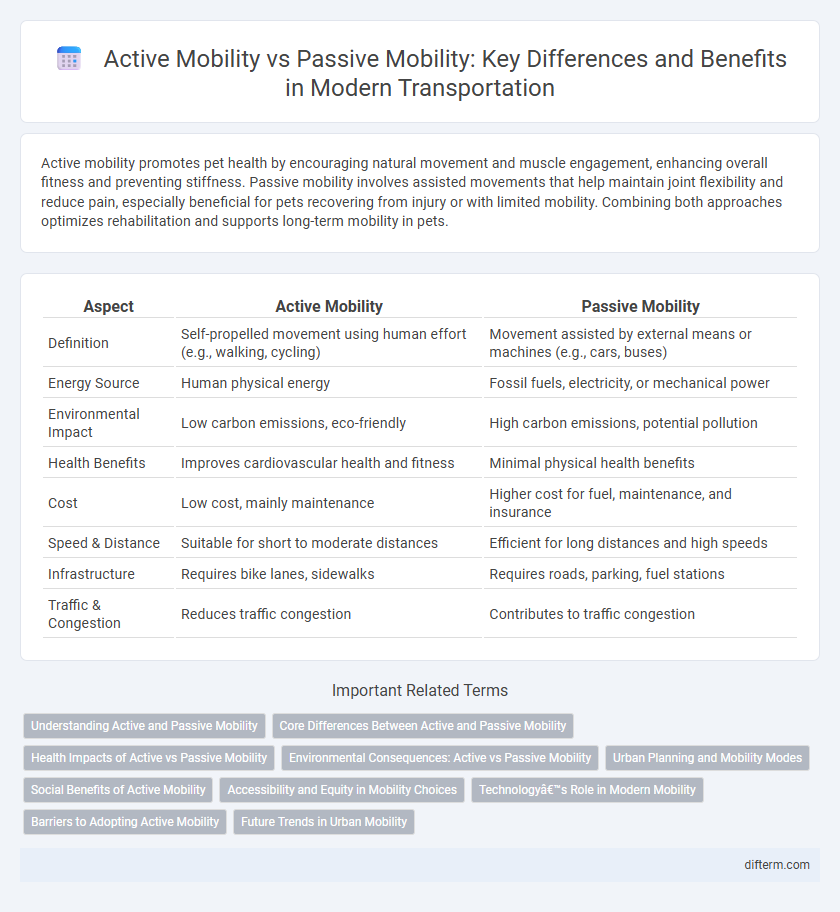Active mobility promotes pet health by encouraging natural movement and muscle engagement, enhancing overall fitness and preventing stiffness. Passive mobility involves assisted movements that help maintain joint flexibility and reduce pain, especially beneficial for pets recovering from injury or with limited mobility. Combining both approaches optimizes rehabilitation and supports long-term mobility in pets.
Table of Comparison
| Aspect | Active Mobility | Passive Mobility |
|---|---|---|
| Definition | Self-propelled movement using human effort (e.g., walking, cycling) | Movement assisted by external means or machines (e.g., cars, buses) |
| Energy Source | Human physical energy | Fossil fuels, electricity, or mechanical power |
| Environmental Impact | Low carbon emissions, eco-friendly | High carbon emissions, potential pollution |
| Health Benefits | Improves cardiovascular health and fitness | Minimal physical health benefits |
| Cost | Low cost, mainly maintenance | Higher cost for fuel, maintenance, and insurance |
| Speed & Distance | Suitable for short to moderate distances | Efficient for long distances and high speeds |
| Infrastructure | Requires bike lanes, sidewalks | Requires roads, parking, fuel stations |
| Traffic & Congestion | Reduces traffic congestion | Contributes to traffic congestion |
Understanding Active and Passive Mobility
Active mobility involves self-powered transportation modes such as walking and cycling, which promote physical health and reduce environmental impact by minimizing carbon emissions. Passive mobility relies on external energy sources like cars, buses, and trains, offering convenience and speed but contributing to air pollution and traffic congestion. Understanding these distinctions helps urban planners design sustainable transportation systems that prioritize public health and environmental sustainability.
Core Differences Between Active and Passive Mobility
Active mobility involves the use of human power through activities like walking, cycling, or running, promoting health, reducing environmental impact, and enhancing urban livability. Passive mobility depends on external energy sources such as cars, buses, or trains, offering convenience and speed but contributing to pollution and sedentary lifestyles. Key differences include energy consumption, health benefits, environmental footprint, and infrastructure requirements.
Health Impacts of Active vs Passive Mobility
Active mobility, such as walking and cycling, significantly improves cardiovascular health, reduces obesity risk, and enhances mental well-being by promoting regular physical activity. Passive mobility, relying on motorized transport, contributes to sedentary lifestyles linked with higher prevalence of chronic diseases such as diabetes and hypertension. Public health studies reveal that communities with higher active mobility engagement experience lower healthcare costs and improved overall population health outcomes.
Environmental Consequences: Active vs Passive Mobility
Active mobility, such as walking and cycling, significantly reduces carbon emissions by relying on human energy instead of fossil fuels, thereby minimizing air pollution and greenhouse gas output. Passive mobility, including cars and buses powered by internal combustion engines, contributes extensively to urban air quality degradation and climate change due to high levels of CO2 and particulate matter emissions. Promoting active mobility leads to sustainable urban environments, decreased noise pollution, and improved public health by lowering the environmental footprint of daily transportation.
Urban Planning and Mobility Modes
Active mobility, involving walking and cycling, significantly enhances urban planning by reducing congestion, lowering emissions, and promoting healthier lifestyles. Urban planners prioritize dedicated bike lanes, pedestrian zones, and connectivity to public transit to support seamless integration of active mobility modes. Passive mobility, such as car and bus use, relies on infrastructure capacity and traffic management but often contributes to urban sprawl and pollution challenges.
Social Benefits of Active Mobility
Active mobility, such as walking and cycling, significantly enhances public health by reducing obesity rates and cardiovascular diseases through increased physical activity. It fosters social interaction and community cohesion by encouraging local engagement and reducing reliance on private vehicles. Furthermore, active mobility decreases air pollution and noise levels, improving overall urban livability and mental well-being.
Accessibility and Equity in Mobility Choices
Active mobility, including walking and cycling, enhances accessibility by providing affordable and flexible transportation options that reduce reliance on motor vehicles. Incorporating safe, inclusive infrastructure supports equitable mobility choices, ensuring underserved communities have improved access to employment, education, and essential services. Passive mobility options like public transit complement active modes but must be designed to address disparities in coverage and affordability to promote social equity.
Technology’s Role in Modern Mobility
Technology propels active mobility by integrating smart sensors and wearable devices that monitor physical activity and optimize routes for walking and cycling. Advanced applications use real-time data and AI algorithms to enhance safety and efficiency, encouraging sustainable habits over passive transportation modes. Urban infrastructure increasingly incorporates IoT and intelligent traffic management systems, seamlessly connecting active mobility with public transit networks and reducing dependence on private vehicles.
Barriers to Adopting Active Mobility
Barriers to adopting active mobility include inadequate infrastructure such as lack of safe bike lanes and pedestrian pathways, which significantly deter walking and cycling. Concerns about personal safety and exposure to pollution further reduce the appeal of active mobility options. Limited accessibility to amenities and poor weather conditions also contribute to the reluctance in embracing walking and biking as primary modes of transportation.
Future Trends in Urban Mobility
Active mobility, including walking and cycling, is increasingly prioritized in urban planning to reduce emissions and improve public health. Urban areas are integrating advanced infrastructure such as dedicated bike lanes, smart crosswalks, and micro-mobility hubs to support seamless, eco-friendly transit. Future trends emphasize multimodal networks combining active mobility with electric public transport to enhance accessibility and sustainability.
active mobility vs passive mobility Infographic

 difterm.com
difterm.com